Jump to:
Can you dye your hair after bleaching? If so, how long should you wait before applying any color? If you’re asking either of these questions, you’re in the right place. We’ll show you all this and more below.
Can You Dye Your Hair After Bleaching?
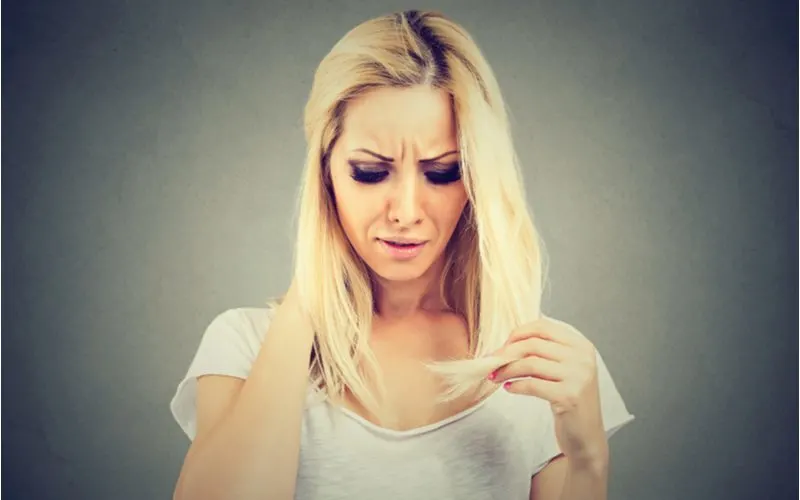
pathdoc/Shutterstock
If you’re looking forward to coloring your hair but wondering; Can you dye your hair after bleaching? In short, yes you can. But we don’t recommend it. For best results, give your hair at least a day or two before dyeing.
Whether you color your hair at home or in a professional studio, the last thing you want is a poor outcome. When doing it for the first time, the chances are that you’ll worry about the time it takes to color your hair after applying bleach.
Preparing for a change in style requires knowledge and patience. While hair coloring may seem like a straightforward process, it is a complex procedure that a knowledgeable professional should perform.
Even with the professional treatment, you could have questions on the best steps to take when bleaching and coloring your hair and the things to consider throughout this process. This guide will explore these concerns in detail.
Steps to Take Before Bleaching Your Hair
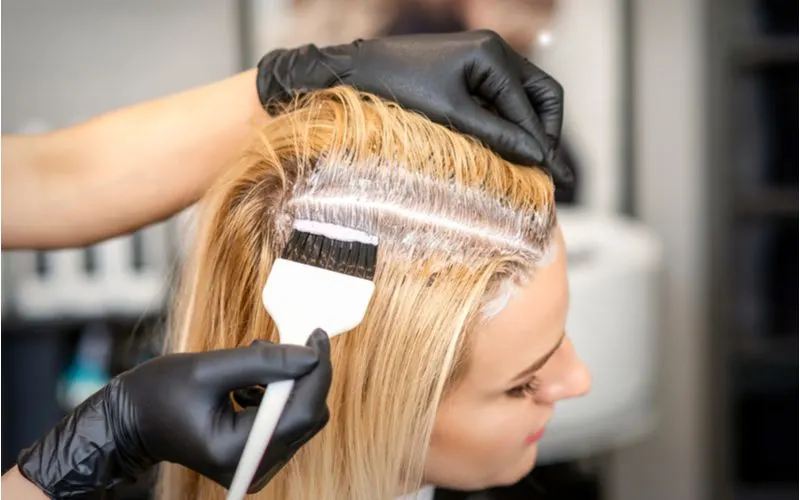
Michelle Aleksa/Shutterstock
If you’re planning to attain bright and pastel colors, you may want to pre-lighten your hair. You should consider several things if you’re to do this correctly.
1. Using Deep Conditioner Weeks Before You Bleach
When you bleach your hair, it depletes its moisture. So, a few days before bleaching it, be sure to add extra moisture to your hair. It’s also vital that you strictly adhere to the directions on your deep conditioning mask and rinse the treatment with cool water after it sits for the recommended time.
2. Test Your Bleach Before Using It on Your Hair
Before using any bleach, test for its efficacy 48 hours before using it on your hair. Be sure to mix two parts developer and 1-part bleach powder. Apply a small amount on your hand, coat your hair strand and then rinse it off after 30 minutes.
This test will help you tell your desired shade after applying bleach to your hair. Ensure that your skin isn’t irritated by the bleach. If it is, you may want to shorten your processing time.
3. Visit a Professional for the Best Outcome
While hair bleach can negatively affect your skin and hair, research shows that you can use such products and suffer less hair damage. You should leave this task to a professional hairdresser as they know products that cause less hair damage and don’t have a pungent smell.
4. Be Sure to Use Bleach With Nourishing Ingredients
If you decide to bleach hair by yourself, ensure that you use bleach with nourishing ingredients. High-quality bleaches will include additives that will prevent severe hair damage.
Protecting Your Hair During and After Bleaching
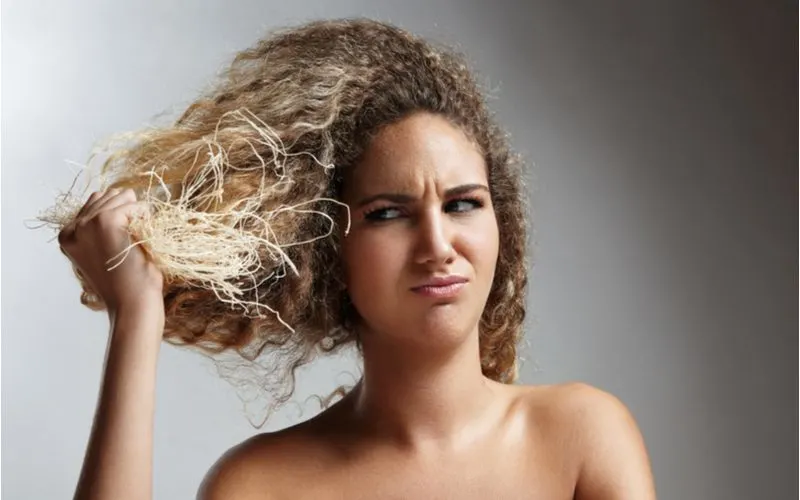
Beauty Stock/Shutterstock
If you’ve got healthy virgin hair, bleaching for the first time may not be harsh on your hair. However, if you plan to do it more than once for a lighter color, you’ll be compromising your hair health. Luckily, you can take different approaches to maintain healthy hair and scalp.
Avoid Bleaching More Than Once a Day
Statistics show that only 3% of the global population has blonde hair. So, if this is the type of hair type you wish to attain, be sure to bleach once.
You can do it a second time, but you should give your hair at least one week to recuperate before you bleach it again. This way, your scalp, and hair will have enough time to recover.
Minimize Your Hair Damage With Volume Developer
Most people who plan to bleach their hair tend to ignore low-volume developer because it’s a weak bleach, and it takes a while before you get the results you want. While this may seem like a disadvantage to some people, it will help minimize the risk of hair damage.
Coloring Your Hair
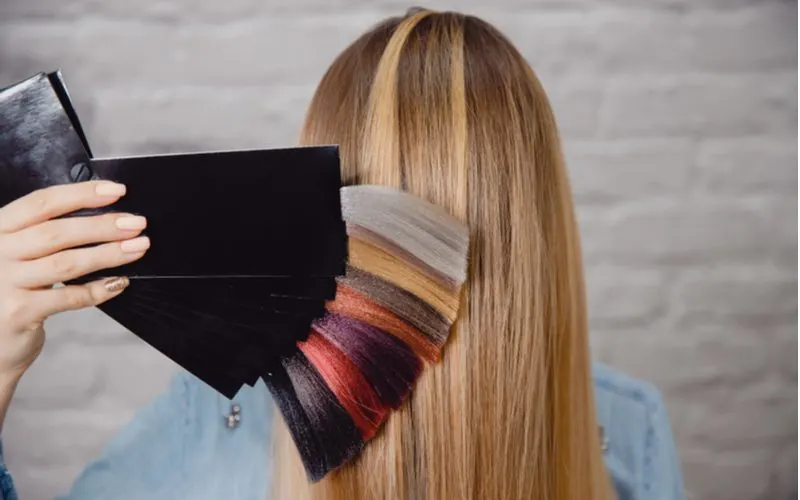
Parilov/Shutterstock
Market analysts estimate the world’s hair color market to be $17,800 million, and they believe that this number will grow to $32,600 by the end of 2025. So, this means that there are plenty of products you can use to attain the style you desire.
However, don’t be too quick to pick any of the products and start coloring your hair. Instead, choose a time when you aren’t too tired to achieve the results you’re looking for. Here’s how you can dye your hair for the best results.
Choose Your Preferred Hair Color
When you bleach your hair, it’ll turn reddish, white or yellow, and in this state, it takes on color quickly. To achieve a natural color effect, be sure to stay at least three colors in your shade.
For instance, if your hair turns yellowish after bleaching and you plan to use a blue base color, you’ll end up with greenish hair. So, you’ll get the best results by using a violet base color to remove your hair’s yellow color.
Determine the Period Your Color Will Last
There are plenty of store-bought dyes available in the market like color rinses, semi-permanent and permanent and they last different times in your hair. Permanent dyes produce natural-looking colors and last longer on your hair.
Semi-permanent dyes last after 20 to 25 washes, and they can dye your hair two shades darker. The temporary dyes are useful for experimenting with different hair colors, and they wash out in three rinses.
Deep Condition Your Hair
After you bleach your hair, wait for two days before you deep condition. This step increases your hair’s elasticity and moisture, ensuring that you don’t end up with dry, brittle hair.
Consider Using a Protein Filler
Before applying the dye, add protein filler to your hair before rinsing it out with warm water. Alternatively, you can mix your hair dye with protein filler. Don’t add too much, as your dye will be too runny.
Test for Allergic Reactions
It’s advisable to do a patch allergy test, as this will help you know whether or not your dye can cause an allergic reaction. If it does, try different products until you find one that works well.
Avoid Stains
Dyes can stain your hands and skin, which is why you should use an old towel to cover your clothes and gloves on your hands. Additionally, add small amounts of jelly along your neck and hairline to prevent stains. Keep a bottle of alcohol facial toner to remove spillages from floors, countertops and your skin.
Apply Dye to Your Hair
Start by dividing your hair into four sections, then pin down the other three sections while applying dye on the fourth. Apply your dye in about 1-inch sections beginning from the roots to the tip.
After applying all the areas, rub your dye throughout your hair as though you’re shampooing.
Rinse and Let It Dry
After applying your conditioner, leave it for about 20 minutes, then rinse it with warm water until it runs clear. Use a towel to dry your hair and let it dry naturally. Remember that the color of wet hair will look darker than the actual color.
Things to Consider when Dyeing Hair After Bleach
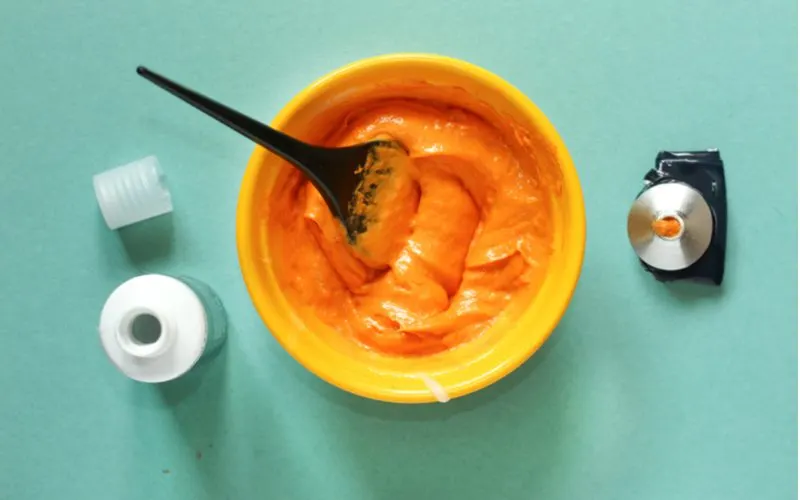
Elene Kitch/Shutterstock
Coloring your hair after bleaching is a complex process that breaks the fatty acids causing your hair to be dry and prone to breakages. That being the case, here are a few things to keep in mind throughout this process.
- Don’t bleach hair yourself. It’s advisable to seek the help of a friend or go to a professional salon. You can miss some spots or apply it unevenly by doing it yourself.
- Don’t leave the bleach on your hair for too long as it can damage the skin of your head.
- Don’t forget to deep-condition your hair when the mane discolors. This makes your strands easy to comb, and it returns the required nutrients after bleaching.
- Perform a strand test before bleaching your hair. This way, you’ll be confident that there won’t be any unpredictable color change to your locks.
- If you have dark locks and need to color them repeatedly to get your desired shade, wait for several weeks before each procedure to help your strands restore.
Frequently Asked Questions
Here are some of the commonly asked questions:
Can You Dye Your Hair The Same Day You Apply Bleach?
Yes, you can bleach and apply dye on your hair the same day. However, take a break after bleaching as doing it so immediately can affect your hair health.
How Long Should You Wait After Bleaching to Dye Your Hair?
If you want to dye your hair after bleaching, wait two weeks before coloring it. You don’t need to wait this long if your hair feels strong. But it never hurts to wait out of an abundance of caution.
Can You Dye Wet Hair After Bleaching?
No, it isn’t advisable to dye wet hair after bleaching. The bleaching process makes your hair brittle, dry and prone to breakage. By coloring your hair immediately, the bleach may cause further damage.
Is It Okay to Condition Hair After Bleaching Before Coloring?
Yes. We suggest deep conditioning your hair after you’re finished. When you condition it after bleaching, you’ll have to repeat the same process when adding color.
Can You Bleach Your Hair After Dyeing It?
If you dyed your hair a dark color and wish to turn it to a lighter color, you’ll need to bleach your hair to lift the dark cues before replacing them with lighter ones.
So, Can You Dye Your Hair After Bleaching?
From this guide, you now know that it’s possible to dye your hair after you bleach. Before you proceed, wait for two weeks after dyeing your hair before you bleach to prevent damaging your hair. Ensure that you retouch your dye after two months as it will fade over time.
